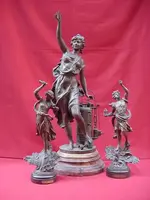There is no reason to assume that because different metals were used the object in his hand is not original. Sometimes when a sculpture has parts that are small or delicate, they are cast in stronger materials so they hold up better. Also, with cheap castings, it is not uncommon to see the detailed bits made by someone else with more skill (or stamped out by a machine) and inserted into the main sculpture upon finishing. Either way, I don't see anything particularly indicative of any particular person or deity. Poseidon carried a trident and is usually portrayed as a bearded older man. Thor carried a hammer, but again -- usually bearded and the dress is all wrong. The twining vines around the central staff makes me think of Mercury (or Hermes) -- the messenger of the gods, but also the god of medicine. However the twining vines should have been two snakes and the hammer should have been wings. The leaves might be symbolic of "Leif" Erickson -- the hammer was a favorite Viking weapon as well (though it didn't really look like that one) but the clothing is all wrong for Vikings. Vulcan (or Hephaestus) was the god of the forge and used a hammer -- also would have been clothed liked that -- but he was lame, and I can think of no reason he would be at the helm of a ship with a modern looking ship's wheel. So... nothing really fits very well.
Maybe it isn't a "who" so much as a "spirit" or ideal that this depicts. Like victory, or hope, or love, etc. (Not those -- just examples of what I mean.) Maybe it is the spirit of exploration, or the embodiment of youth and adventure, or something like that?
Breezie



